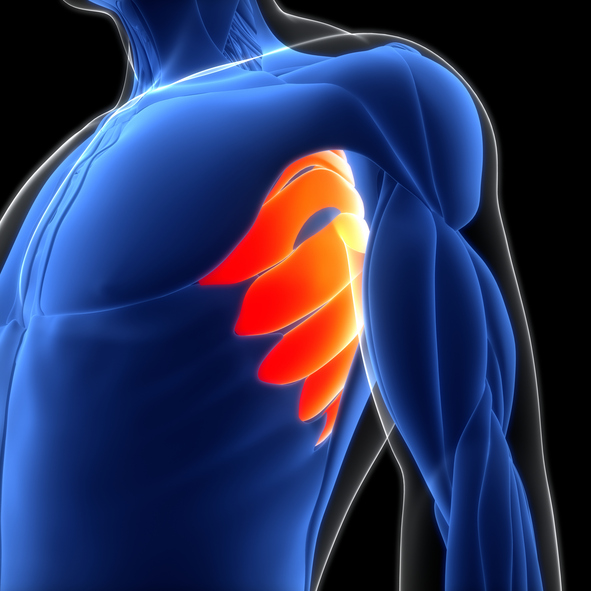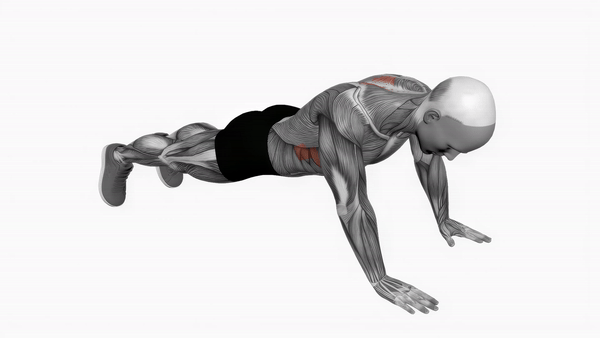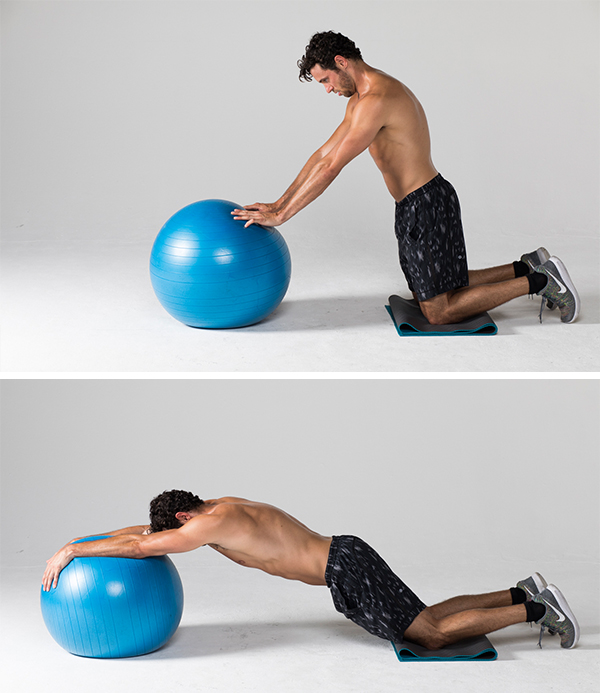Want to press more weight, do more push-ups, improve shoulder mobility, and look super-heroic with your shirt off? You may want to focus on doing more serratus anterior exercises.
The serratus may not get the love that big muscles like the pecs, glutes, and abs get on social media (no one’s going to post about their one-rep max on the serratus wall slide). But this saw-toothed muscle on the sides and back of your rib cage is a key player whenever you press, push, or punch, and when it’s well developed — bonus — it looks super cool as well.
Here’s a primer on how the serratus anterior muscles work — and some key moves for best developing this stealthily awesome group.
Serratus Anterior Anatomy and Function
In any big company, there are a few behind-the-scenes players who don’t get the recognition they deserve. In your upper body, that’s the serratus anterior.
Much of the serratus is hidden beneath the shoulder blade, the latissimus dorsi (the back muscle on the side of your torso), and the pectoralis (chest muscle). The only visible serratus muscles are two or three finger-shaped horizontal bumps on the sides of your rib cage, a couple of inches below your armpits.
Serratus anterior insertion

If you could look beneath your lats, pectoral muscles, and shoulder blades (scapulae), you’d see that there are actually eight (sometimes nine) of those fingers of the serratus anterior, each one originating on a different rib.
Like a giant thoracic bandage, these parallel strips of sinew each wrap around the back of your rib cage, slipping underneath your lat and scapula, and inserting at the medial border (inside edge) of your shoulder blade.
When you’re lean, the serratus jumps out visibly, especially when you expand your scapulae into a lat spread, framing the top corners of your ab muscles like a pair of quotation marks turned on their sides.
Serratus anterior action
The structure of this muscle may be complex, but its job is simple: to slide your shoulder blades forward (protraction) and rotate them upwards (flexion).
If those don’t sound like important functions, move your arm around. You’ll see that virtually every movement of your arm also requires you to move your shoulder blade: reach forward, your scapula slides forward; reach up, it lifts up. Your serratus is pivotal in making both things happen.
Physiotherapists sometimes call the serratus the “boxer’s muscle” or the “big swing” muscle, and now you know why: Without those serratus muscles sliding your shoulder blades forward, most punches would fall six or eight inches short.
9 of the Best Serratus Anterior Exercises
Good news: You don’t need to do a serratus anterior workout to increase its strength and definition. It’s a synergist — a helper-muscle — in many of the classic moves you’re likely already doing for your chest, deltoids, back, and core, as shown below.
Want to emphasize serratus anterior activation in these moves? Focus on a complete scapular range of motion — moving your shoulder blades forward, backward, upward, and downward — whenever you can.
1. Push-up
Additional muscles worked: chest, triceps
- Assume a high plank position: hands and balls of your feet on the floor, core tight, and body straight from head to heels. Your hands should be slightly wider than your shoulders.
- Maintaining a rigid posture, slowly lower your chest to the floor — or as close as you can without breaking form.
- Reverse the move, pushing yourself back up to the starting position.
Too tough? Perform the move with your hands elevated on a box or bench.
2. Serratus push-up

Additional muscles worked: shoulders, chest
- Assume a high plank position: hands and balls of your feet on the floor, core tight, and body straight from head to heels. Your hands should be slightly wider than your shoulders.
- Keeping your arms straight and your body rigid, slowly retract (pull back) your shoulder blades as far as possible.
- Pause, push back up to the starting position, protract (spread) your shoulder blades, and round your upper back as much as possible toward the ceiling.
- Pause and return to the starting position.
3. Supine chest press
Additional muscles worked: chest, triceps
- Lie back on a bench, holding a dumbbell firmly in each hand at arm’s length above your shoulders with your palms facing forward.
- Slowly lower the dumbbells, stretching your chest muscles fully, until the inside plates of the dumbbells are close to — or nearly touching — your chest.
- Pause, return to the starting position, and then push the dumbbells as high as possible, lifting your shoulder blades off the bench.
- Lower and repeat.
No dumbbells? Perform the same move using a barbell.
4. Standing serratus press
Additional muscles worked: shoulders, chest
- Attach two exercise bands with handles to a squat rack at shoulder height.
- Face away from the rack, take hold of the handles, and extend your arms in front of you, parallel to the floor.
- Walk forward to create tension on the bands.
- Assume a half-lunging position with one foot forward for stability.
- Keeping your torso upright and your entire body stable, push your arms forward as far as possible, rounding your upper back. This is your starting position.
- Keeping your arms straight and your posture upright, slowly retract your shoulder blades as much as possible.
- Slowly return to the starting position. That’s one rep.
5. Pullover
Additional muscles worked: lats, triceps, posterior delts
- Lie back on a bench holding two light- to medium-weight dumbbells with a firm grip at arm’s length above your chest.
- Keeping your arms straight, press the dumbbells toward one another and hold them there throughout the move (this works best with hexagonal dumbbells).
- Keeping your feet planted on the floor and your elbows slightly bent, slowly lower the dumbbells in an arc towards the floor over your head, until you feel a deep stretch in your lats and rib cage.
- Pause for a moment, slowly reverse the move, and return to the starting position.
6. Ab rollout

Additional muscles worked: core, triceps
- Choose a ball: bigger (up to 33 inches in diameter) if you’re just learning the move, smaller (18 inches in diameter) once you’ve had more practice.
- Kneel behind the ball, fold at the waist, and place your forearms on top of the ball, palms down.
- Tighten your abdomen, tuck your pelvis, and maintain that position throughout the movement. If you feel your lower back arch, stop the set.
- Lean your weight onto the ball and slowly extend your arms in front of you, rolling the ball forward as far as you can while maintaining the same position in your lower back.
- Pause for two to three seconds in the fully extended position.
- Reverse the movement, slowly returning to the starting position.
7. Serratus wall slide
Additional muscles worked: shoulders
- Stand facing a wall.
- Place your forearms on the wall, vertically, about shoulder width apart with your palms facing each other.
- Lean your weight into the wall, spread your shoulder blades, and round your back backward. This is your starting position.
- Maintaining the same rounded back position, slowly slide your forearms along the wall upwards and downwards as far as you can.
8. Bear crawl
Additional muscles worked: core, chest, triceps
- Get on all fours with your hands directly under your shoulders, fingers spread wide, and your knees bent 90 degrees below your hips.
- Tuck your toes and raise your knees slightly off the floor. This is your starting position.
- Keeping your back flat and core engaged, move forward using a “cross-crawl” pattern, simultaneously moving opposite hands and feet together (left hand and right foot, right hand and left foot).
- Continue moving forward with opposite hands and feet in unison for the specified number of steps, then reverse the movement to work your way back.
9. Standing rotational punch
Additional muscles worked: core, shoulders
- Stand with your feet slightly wider than your shoulders, holding a pair of light-to-medium dumbbells at chest or shoulder height, with your palms facing each other.
- Turn your torso 90 degrees to your left, pivoting on your right foot as you punch straight out from your shoulder with your right hand, rotating your fist until your palm faces downward.
- Return smoothly to the starting position and repeat the move to the other side, rotating on your left foot and punching to your right with your left hand.
- Alternate sides smoothly.
Benefits of Serratus Anterior Exercises
Although they appear most visibly on your ribs, the muscles of the serratus anterior are crucial to shoulder health. Strengthening them can help with a number of scapulothoracic tasks.
1. Increased shoulder mobility
When the serratus isn’t working as it should, your shoulder blade may not slide as easily across your back, limiting your range of motion — and possibly causing pain — when you reach your arm forward or overhead. A strong serratus can help increase range of motion, with downstream benefits for rotator cuff function.
2. Improved upper-body performance
Nearly every arm motion involves the shoulder blade and nearly every shoulder blade motion involves the serratus anterior. Presses, punches, and pitches all benefit from a strong serratus anterior — as does putting away dishes on the top cabinet.
3. Muscular balance
Over time, repeated overhead movement can cause an imbalance between the serratus and the trapezius, the kite-shaped muscle connecting your neck, back, and shoulders. Exercises that target the serratus can help restore order.
4. Less scapular winging
A weak serratus anterior can also lead to a protrusion of the shoulder blades, referred to as scapula alata, or scapular winging. Strengthening the serratus can help bring the scapulae into alignment.

